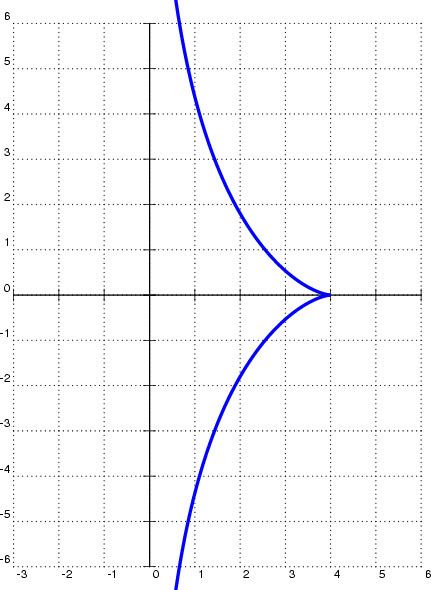 | ||
A tractrix (from the Latin verb trahere "pull, drag"; plural: tractrices) is the curve along which an object moves, under the influence of friction, when pulled on a horizontal plane by a line segment attached to a tractor (pulling) point that moves at a right angle to the initial line between the object and the puller at an infinitesimal speed. It is therefore a curve of pursuit. It was first introduced by Claude Perrault in 1670, and later studied by Isaac Newton (1676) and Christiaan Huygens (1692).
Contents
Mathematical derivation
Suppose the object is placed at (a,0) (or (4,0) in the example shown at right}, and the puller in the origin, so a is the length of the pulling thread (4 in the example at right). Then the puller starts to move along the y axis in the positive direction. At every moment, the thread will be tangent to the curve y = y(x) described by the object, so that it becomes completely determined by the movement of the puller. Mathematically, the movement will be described then by the differential equation
with the initial condition y(a) = 0 whose solution is
The first term of this solution can also be written
where arsech is the inverse hyperbolic secant function.
The negative branch denotes the case where the puller moves in the negative direction from the origin. Both branches belong to the tractrix, meeting at the cusp point (a,0).
Basis of the tractrix
The essential property of the tractrix is constancy of the distance between a point P on the curve and the intersection of the tangent line at P with the asymptote of the curve.
The tractrix might be regarded in a multitude of ways:
- It is the locus of the center of a hyperbolic spiral rolling (without skidding) on a straight line.
- The involute of the catenary function, which describes a fully flexible, inelastic, homogeneous string attached to two points that is subjected to a gravitational field. The catenary has the equation y(x) = a cosh x/a.
- The trajectory determined by the middle of the back axle of a car pulled by a rope at a constant speed and with a constant direction (initially perpendicular to the vehicle).
The function admits a horizontal asymptote. The curve is symmetrical with respect to the y-axis. The curvature radius is r = a cot x/y.
A great implication that the tractrix had was the study of the revolution surface of it around its asymptote: the pseudosphere. Studied by Eugenio Beltrami in 1868, as a surface of constant negative Gaussian curvature, the pseudosphere is a local model of non-Euclidean geometry. The idea was carried further by Kasner and Newman in their book Mathematics and the Imagination, where they show a toy train dragging a pocket watch to generate the tractrix.
Properties
Practical application
In 1927, P. G. A. H. Voigt patented a horn loudspeaker design based on the assumption that a wave front traveling through the horn is spherical of a constant radius. The idea is to minimize distortion caused by internal reflection of sound within the horn. The resulting shape is the surface of revolution of a tractrix.
An important application is in the forming technology for sheet metal. In particular a tractrix profile is used for the corner of the die on which the sheet metal is bent during deep drawing.
Drawing machines
A history of all these machines can be seen in an article by H. J. M. Boas.
